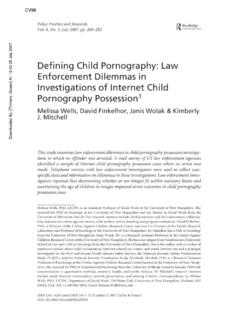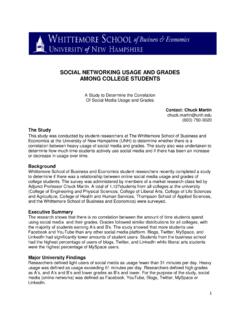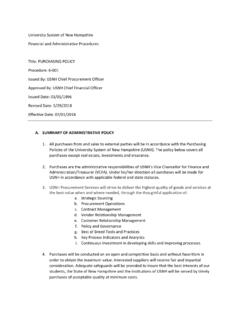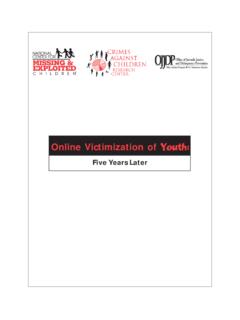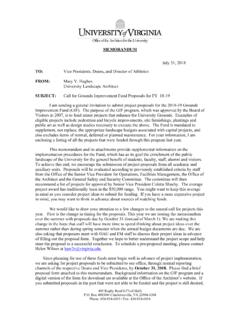Transcription of Subj: Educational and General (E&G) Facility Repair and ...
1 Subj: Educational and General (E&G) Facility Support PURPOSE Provide an overview of Facility Operations, maintenance , Repair and Renovation and Space Management Procedures and Practices. KEY DEFINITIONS Building: A building includes all systems that are permanently incorporated or attached to the structure. Autoclaves that are built into walls, permanently installed walk-in refrigeration, freezer and environmental chambers, fume hoods, fixed seating, etc. are normally considered part of the building. maintenance , Repair and replacement of building systems and components are the responsibility of UNH Facilities. Building Automation System (BAS): Heating, ventilation and air conditioning systems and lighting systems in newer buildings in the core campus are controlled by a central BAS system. This sophisticated system combines status information such as outside and inside temperatures, occupancy, class schedules, pump operation, etc. and optimizes energy use while maintaining occupant comfort.
2 BAS technicians from the Energy office operate and maintain this system and its components. Deferred maintenance : Given the age of buildings and the wear and tear of daily use, the sum of all budgets allocated to the institutional physical plant assets are inadequate to respond to all Facility needs. As such, as a normal course of business, Facility managers must prioritize needed work and routinely put off that which is lower priority in order to operate within available funds. The accumulated cost of such work, whether maintenance or Repair , is categorized in the somewhat misleading term deferred maintenance and is a measure of the overall condition of our facilities and infrastructure. Facilities Energy & Utilities: Energy and Utilities is responsible for campus-wide utility and energy systems including building automation systems and chiller plants. Facilities Operations and maintenance : Facilities Operations and maintenance is responsible for housekeeping, grounds & special event support, and, preventive and unscheduled maintenance of all building systems, with the exception of BAS components.
3 maintenance personnel are organized into Zone maintenance Teams that are aligned with specific buildings on campus. Facilities Control Center (FCC): The Control Center serves campus customers as the single point of contact to report and request assistance with any Facility related need on campus. The Control Center refers or routes all reports and requests to the appropriate office for follow-up action. Furniture, Fixtures and Equipment (FF&E): Loose items including bench top equipment, portable autoclaves, scales, desks and other loose furniture, free standing refrigerators, freezers and environmental control chambers, other appliances and program specific equipment and apparatus, window air conditioners, etc. are generally not considered part of the building. maintenance , Repair and replacement of such loose items are the occupant s responsibility. maintenance : Facility maintenance includes those tasks to keep facilities and systems in clean and proper working condition. Filter and belt changes, lubrication of moving parts, winterizing cooling systems in the fall and securing heating systems in the spring are common tasks.
4 maintenance also includes functions such as housekeeping services and grounds care, trash removal, seasonal road restriping and a number of other routine and generally cyclic activities that keep the campus buildings and infrastructure in working order. Minor and Major Repairs: Generally, minor repairs include work to restore an existing system or component to proper operation that requires less than 16 hours of labor or less than $5000 to accomplish. Major Repair would be work that exceeds this level of effort or cost. Net Assignable Square Feet (NASF): The area within a building such as an office, lab, Telcom closet, or classroom assignable to an RC-Unit. Does not include lobbies, stairs, common restrooms, elevators and other General use space or the space taken up by exterior or interior walls. Related terms are gross square feet (the area of the building based on the exterior dimensions) and net square feet (the interior area of the building after the space taken by exterior and interior walls is deducted.)
5 Facility Operation: Utility and building systems require varying degrees of ongoing effort so that they properly, safely and reliably function as intended. The Co-Gen Plant, central hot water system, electric distribution system, water plant, building heating, ventilation and air conditioning systems in our major buildings and our campus-wide BAS all require day to day operation by qualified technicians. Snow removal also falls into the category of a Facility operation. RCM Facility Charge: Units are allocated an RCM square foot charge on the net assignable square feet (NASF) of building space occupied. This charge allocates the cost for the following services to E&G units and certain auxiliary units for space occupied in the core campus. A more detailed description of the facilities RCM policy can be found within the VPFA website at: and the annual facilities rate model and allocation by RC unit can be found at: : o Facilities Operation and maintenance . This activity includes management, supervision and accomplishment of Housekeeping, Grounds and Special Event Support, Building maintenance , Materials Warehouse, and Information Technology.
6 A detailed scope of work defining all aspects of this work is under development. o Utility and energy system operation and maintenance . o Facilities asset management ( , long range and capital project development, condition assessment, major Repair and renovation planning, etc.) o Repair and Renovation (R&R) Fund. The R&R rate for core campus space includes an allocation to the annual R&R fund. However, the RCM rate for outlying areas such as the COLSA farm and agricultural properties, Auxiliary Enterprises, and UNH-Manchester does not include any allocation to the R major Repair , renovation and alteration costs of these facilities are funded directly by the occupant unit. Space Allocation Repair and Renovation Committee (SARRC): Approves all R&R projects, air conditioning requests, and reassignment of all space between RC-Units. Members are the five vice presidents and a representative from student senate and faculty senate. Telecommunications and Data Systems: Permanently installed wiring, routers, wireless access points, and end devices (plug in outlets) are part of the system operated and maintained by CIS.
7 Computers, telephones and other devices are the occupant s responsibility. Occupants are charged a fee for data or voice lines. Computers and related equipment in computing clusters managed by CIS and in technology enhanced classrooms that are managed by the Registrar are purchased and supported by CIS using funds collected through the student technology fee. The technology fee also covers part of the salary of the college-based Academic Technology Liaisons (ATLs). Departmental computing facilities may be supported by the department or may be supported by CIS through a fee-based service level agreement. University Repair and Renovation Fund (R&R): This central fund is managed by SARRC. The RCM square foot charge for space in the core campus includes an allocation of the R&R fund. All units, including Auxiliary units pay an allocation in an amount equal to 10% of the annual SARRC budget as contribution toward campus-wide exterior landscape, walks and utility systems, and separately fund all R&R work within auxiliary enterprise facilities.
8 Facility OPERATION AND maintenance Funding Sources: Operation and maintenance (O&M) of the campus buildings and infrastructure is funded from the RCM net assignable square foot charge levied to each RCU. Auxiliaries are generally billed for the services provided. This includes billing for utilities consumed and an allocation of General services such as grounds care. Delivery: Facilities Operations and maintenance delivers building and grounds O&M services. Energy and Utilities is responsible for delivering utility services such as water and electricity to campus buildings and for operation of the BAS which controls heating and air conditioning in new or recently renovated buildings. Both groups use a combination of UNH personnel and outside contractors to accomplish the wide variety of tasks necessary. Campus customers can call the Facilities Control Center (2-1437) regardless of the type of Facility issue. The FCC will route the matter to the appropriate staff. Facility Repair , RENOVATION AND ALTERATION Funding Sources: Facility Repair , renovation, and alteration may be funded from several sources including: o Grants o Gifts or donations o College or department operating budgets o State Capital Appropriation o Facilities Operations and maintenance operating budget.
9 The Operations and maintenance budget funds building maintenance and minor repairs. The RCM square foot charge for space in the core campus includes an allocation of the Operations and maintenance budget. o Energy and Utilities operating budget. Similar to Operations and maintenance but funds utility and energy system operation, maintenance and minor repairs. Note: Grants and gifts may be restricted to renovation and alteration work and state capital appropriations are typically designated to specific projects. project Approval: o maintenance and Minor Repair . Projects that keep or restore existing facilities in working order are approved by Operations and maintenance . o Major maintenance and Repair . Annually, Facilities prepares a major maintenance and Repair plan for SARRC approval. This plan includes work such as repaving roads, replacing roofs, upgrading fire alarms, repairing utility distribution systems and removing accessibility barriers. This subset of the R&R fund is referred to as Institutional R&R.
10 O Alteration and Renovation. Regardless of fund source or method of accomplishment, ALL projects that renovate or alter existing campus facilities must be reviewed and approved by Facilities project Management (FPM) to insure consistency with campus standards and compliance with applicable building and life safety codes. Facilities project Management is responsible for coordinating any other technical, code or external approvals as may be necessary depending on the nature of the work ( projects with a cost over $1 million must be approved by the Board of Trustees.) The only exceptions are student housing renovation projects managed by the Housing Office costing less than $1 million. o New Construction. Projects that construct new buildings or structures or expand existing buildings must also be approved by Facilities project Management regardless of location, size, purpose or funding. Facilities PM coordinates other required approvals ( review by the State Fire Marshal s Office.)
